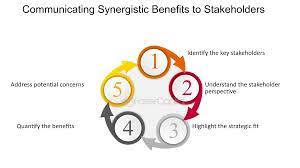In today’s fast-paced and competitive business landscape, organizations are constantly seeking ways to stay ahead of the curve and achieve success. One approach that has gained significant traction in recent years is the use of a synergistic approach. This involves combining different elements or forces to create a greater impact than what could be achieved individually. In this blog post, we will explore the concept of synergy and how it can be harnessed to drive enhanced outcomes in various aspects of business.
Collaborative Synergies: Unleashing Potential
Collaboration is at the heart of a synergistic approach. It involves working together with others to achieve a common goal, leveraging each other’s strengths and resources. When done effectively, collaboration can unleash immense potential and lead to remarkable results. Let us delve deeper into the key elements of collaborative synergies.
Building Trust and Communication
The foundation of any successful collaboration is trust and communication. Without these two crucial elements, it is challenging to establish a strong working relationship and achieve synergy. Trust is built over time through consistent actions and open communication. When team members trust each other, they are more likely to share ideas, take risks, and work towards a common goal without hesitation.
Effective communication is also vital in a collaborative setting. It ensures that all team members are on the same page, understand their roles and responsibilities, and are aware of any changes or updates. Clear and open communication also promotes transparency and fosters a sense of belonging and ownership among team members.
Leveraging Diverse Perspectives
One of the greatest benefits of collaboration is the ability to leverage diverse perspectives. Each team member brings their unique experiences, skills, and knowledge to the table, which can lead to innovative solutions and ideas. By embracing diversity and actively seeking out different viewpoints, teams can tap into a wealth of creativity and unlock new possibilities.
Moreover, diverse perspectives can also help identify blind spots and potential risks that may have been overlooked. This allows for a more comprehensive approach to problem-solving and decision-making, leading to better outcomes.
Aligning Goals and Objectives
For collaboration to be successful, all team members must be aligned on the goals and objectives of the project or initiative. This ensures that everyone is working towards the same end goal and avoids any conflicting efforts. When goals are clear and shared, it becomes easier to prioritize tasks, make decisions, and measure progress.
Moreover, aligning goals also promotes a sense of accountability among team members. Each individual understands their role in achieving the common goal and takes ownership of their responsibilities, leading to a more efficient and effective collaboration.
The Power of Synergy: Unifying Forces for Success
Synergy is often described as the “whole being greater than the sum of its parts.” It is the result of combining different elements or forces to create a synergistic effect that is more significant than what could be achieved individually. Let us explore some of the key ways in which synergy can drive success in various aspects of business.
Enhanced Creativity and Innovation
When diverse perspectives are combined through collaboration, it creates a fertile ground for creativity and innovation. By leveraging each other’s strengths and ideas, teams can come up with unique solutions and approaches that may not have been possible otherwise. This leads to a competitive advantage and sets organizations apart from their competitors.
Moreover, the synergy created by collaboration also encourages risk-taking and experimentation, which are essential for driving innovation. When team members feel supported and empowered, they are more likely to think outside the box and come up with groundbreaking ideas.
Increased Efficiency and Productivity
Collaboration and synergy can also lead to increased efficiency and productivity. By working together, teams can divide tasks and responsibilities based on individual strengths and skills, leading to a more streamlined workflow. This reduces duplication of efforts and minimizes the chances of errors or delays.
Moreover, when team members are aligned on goals and objectives, they can prioritize tasks and make decisions more efficiently. This leads to a more productive use of time and resources, resulting in enhanced outcomes.
Improved Problem-Solving and Decision-Making
In today’s complex business environment, organizations face numerous challenges that require effective problem-solving and decision-making skills. Collaboration and synergy can greatly enhance these abilities by bringing together diverse perspectives and ideas. By leveraging each other’s strengths and experiences, teams can identify potential solutions and make well-informed decisions.
Moreover, the synergy created through collaboration also allows for a more comprehensive approach to problem-solving. By considering various viewpoints and potential risks, teams can develop more robust and effective solutions.
Harnessing Synergies for Transformative Innovation
Innovation is crucial for organizations to stay relevant and competitive in today’s rapidly evolving market. However, it is not always easy to come up with groundbreaking ideas and implement them successfully. This is where harnessing synergies can be a game-changer.
Cross-Functional Collaboration
One of the most effective ways to harness synergies for transformative innovation is through cross-functional collaboration. This involves bringing together individuals from different departments or areas of expertise to work towards a common goal. By combining diverse perspectives and knowledge, cross-functional teams can drive innovation and create transformative solutions.
Moreover, cross-functional collaboration also promotes a better understanding of different functions within an organization. This leads to improved communication and alignment, which can have a positive impact on overall organizational performance.
Embracing Diversity and Inclusion
Diversity and inclusion are crucial for fostering a culture of innovation and driving synergies. By embracing diversity in all its forms, organizations can tap into a wealth of creativity and unique perspectives. This leads to a more inclusive and innovative environment where everyone feels valued and empowered to contribute their ideas.
Moreover, diversity and inclusion also promote a culture of collaboration and trust, which are essential for harnessing synergies. When individuals feel respected and included, they are more likely to share their ideas and work together towards a common goal.
Encouraging a Growth Mindset
A growth mindset is the belief that one’s abilities and intelligence can be developed through hard work and dedication. This mindset is crucial for driving transformative innovation as it encourages individuals to take risks, learn from failures, and continuously improve. By fostering a growth mindset within teams, organizations can create an environment that is conducive to harnessing synergies and driving success.
Synergistic Partnerships: Building Bridges for Growth
Collaboration and synergy are not limited to internal teams within an organization. They can also be harnessed through partnerships with external entities such as suppliers, customers, or other organizations. Let us explore some of the key ways in which synergistic partnerships can drive growth.
Sharing Resources and Expertise
Partnerships allow organizations to leverage each other’s resources and expertise, leading to enhanced outcomes. For example, a company may partner with a supplier who has specialized knowledge or technology that can help improve their products or processes. By sharing resources and expertise, both parties can achieve mutual benefits and drive growth.
Moreover, partnerships also allow for the exchange of best practices and knowledge sharing, which can lead to continuous improvement and innovation.
Expanding Market Reach
Synergistic partnerships can also help organizations expand their market reach and tap into new customer segments. By partnering with complementary businesses, organizations can access new markets and customers that they may not have been able to reach on their own. This leads to increased sales and revenue, driving growth for both parties.
Moreover, partnerships also allow for joint marketing efforts, which can be more cost-effective and impactful than individual marketing strategies.
Mitigating Risks and Uncertainties
In today’s volatile business landscape, organizations face numerous risks and uncertainties that can impact their operations and growth. Synergistic partnerships can help mitigate these risks by sharing resources, knowledge, and expertise. For example, a company may partner with another organization to enter a new market, reducing the risk and cost associated with entering a new market alone.
Moreover, partnerships also allow for joint problem-solving and decision-making, which can lead to more robust and effective solutions.
Leveraging Synergies for Competitive Advantage
In today’s highly competitive business environment, organizations are constantly seeking ways to gain a competitive advantage. Collaboration and synergy can be powerful tools in achieving this goal. Let us explore some of the key ways in which synergies can be leveraged for a competitive advantage.
Differentiation through Innovation
As discussed earlier, collaboration and synergy can drive innovation and lead to unique solutions and approaches. This allows organizations to differentiate themselves from their competitors and stand out in the market. By continuously innovating and leveraging synergies, organizations can stay ahead of the curve and maintain a competitive edge.
Cost Savings and Efficiency
Synergistic partnerships can also lead to cost savings and increased efficiency, providing a competitive advantage. By sharing resources and expertise, organizations can reduce costs and improve their bottom line. This allows them to offer products or services at a lower price point than their competitors, making them more attractive to customers.
Moreover, increased efficiency also leads to faster delivery times and better customer service, which can give organizations a competitive edge.
Building Stronger Relationships
Collaboration and synergy can also help organizations build stronger relationships with their stakeholders, including customers, suppliers, and employees. By working together towards a common goal, organizations can foster a sense of trust and loyalty among their stakeholders. This can lead to long-term partnerships and repeat business, giving organizations a competitive advantage over their competitors.
Creating Synergies through Cross-Functional Collaboration
Cross-functional collaboration is an essential aspect of a synergistic approach. It involves bringing together individuals from different departments or areas of expertise to work towards a common goal. Let us explore some key strategies for creating synergies through cross-functional collaboration.
Establishing Clear Goals and Objectives
As discussed earlier, aligning goals and objectives is crucial for successful collaboration and synergy. This is especially true in a cross-functional setting, where team members may have different priorities and perspectives. By establishing clear and shared goals, organizations can ensure that all team members are working towards the same end goal, leading to enhanced outcomes.
Moreover, clear goals also help in prioritizing tasks and making decisions more efficiently, leading to increased productivity.
Encouraging Open Communication and Feedback
Effective communication is vital in any collaborative setting, but it becomes even more critical in cross-functional collaborations. With team members coming from different backgrounds and areas of expertise, it is essential to establish open communication channels to avoid misunderstandings and conflicts. This includes encouraging feedback and actively listening to each other’s ideas and concerns.
Moreover, cross-functional teams should also establish a process for sharing updates and progress to ensure everyone is on the same page.
Embracing a Culture of Trust and Respect
Trust and respect are crucial for fostering a culture of collaboration and synergy. In a cross-functional setting, team members may not be familiar with each other’s work styles or processes, which can lead to friction. By building trust and respect among team members, organizations can create a safe and inclusive environment where everyone feels valued and empowered to contribute their ideas.
Moreover, trust and respect also promote open communication and transparency, leading to stronger relationships and better outcomes.
The Art of Synergy: Orchestrating Complementary Strengths
Synergy is often described as an art, as it requires a delicate balance of various elements to achieve success. Let us explore some key strategies for orchestrating complementary strengths and driving synergies.
Identifying Complementary Strengths
The first step in orchestrating synergies is to identify complementary strengths among team members or partners. This involves understanding each individual’s skills, experiences, and knowledge and how they can contribute to the overall goal. By leveraging each other’s strengths, teams can create a more comprehensive and effective approach.
Moreover, identifying complementary strengths also helps in assigning roles and responsibilities based on individual strengths, leading to increased efficiency and productivity.
Encouraging Collaboration and Knowledge Sharing
Collaboration and knowledge sharing are crucial for driving synergies. Organizations should encourage team members to work together and share their expertise and ideas. This allows for a more holistic approach to problem-solving and decision-making, leading to better outcomes.
Moreover, knowledge sharing also promotes continuous learning and development, which can lead to improved performance and innovation.
Embracing Flexibility and Adaptability
In today’s dynamic business landscape, it is essential to be flexible and adaptable to change. This is especially true when working towards a common goal through collaboration and synergy. Team members must be open to new ideas and approaches and be willing to adapt to changing circumstances. This allows for a more agile and responsive approach, leading to enhanced outcomes.
Moreover, flexibility and adaptability also promote a growth mindset, which is crucial for driving transformative innovation.
Synergistic Leadership: Driving Success through Unity
Leaders play a crucial role in driving collaboration and synergy within an organization. They are responsible for creating a culture of trust, communication, and alignment that is conducive to harnessing synergies. Let us explore some key strategies for leaders to drive success through unity.
Leading by Example
Leaders must lead by example when it comes to collaboration and synergy. This means actively participating in cross-functional collaborations, seeking out diverse perspectives, and promoting open communication. When team members see their leaders embracing these values, they are more likely to follow suit.
Moreover, leading by example also fosters a sense of trust and respect among team members, leading to a more cohesive and productive team.
Establishing a Common Purpose
For collaboration and synergy to be successful, all team members must have a shared purpose. Leaders play a crucial role in establishing this common purpose and ensuring that it is communicated effectively to all team members. This helps in aligning goals and objectives and promoting a sense of accountability among team members.
Moreover, a common purpose also creates a sense of unity and belonging among team members, leading to enhanced collaboration and outcomes.
Providing Support and Resources
Leaders must provide the necessary support and resources for teams to achieve success through collaboration and synergy. This includes providing access to tools and technology, allocating time and budget for cross-functional collaborations, and offering guidance and mentorship when needed. By providing the right support and resources, leaders can set their teams up for success and drive enhanced outcomes.
Synergy in Action: Case Studies of Successful Collaborations
To truly understand the power of synergy, let us look at some real-life examples of successful collaborations and partnerships.
Apple and Nike
In 2006, Apple and Nike announced a partnership to create a line of fitness products called Nike+. This collaboration combined Apple’s expertise in technology and design with Nike’s knowledge of the fitness industry. The result was a range of products that allowed users to track their workouts and set goals using their iPods and iPhones. This partnership not only led to innovative products but also helped both companies tap into new markets and increase sales.
Starbucks and Spotify
In 2015, Starbucks and Spotify announced a partnership to create a unique music experience for customers. This collaboration involved integrating Spotify’s music streaming service into the Starbucks app, allowing customers to discover and save songs played in-store. This partnership not only enhanced the customer experience but also helped both companies reach a wider audience and increase brand loyalty.
Google and NASA
In 2005, Google and NASA announced a partnership to collaborate on research and development projects. This collaboration allowed Google to access NASA’s expertise in space exploration, while NASA benefited from Google’s advanced technology and data analysis capabilities. This partnership has led to numerous successful projects, including the development of Google Earth and the use of Google’s algorithms to analyze satellite images.
Conclusion
In today’s fast-paced and competitive business landscape, organizations must constantly seek ways to stay ahead of the curve and achieve success. The concept of synergy offers a powerful approach to drive enhanced outcomes in various aspects of business. By leveraging collaborative synergies, organizations can tap into diverse perspectives, unleash potential, and drive transformative innovation. Through partnerships and cross-functional collaborations, they can expand their market reach, mitigate risks, and gain a competitive advantage. With effective leadership and a culture of trust and communication, organizations can harness the power of synergy and achieve remarkable results.




